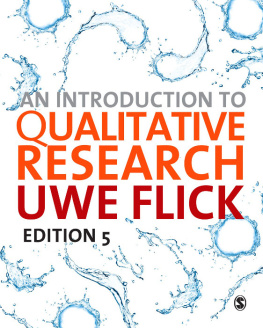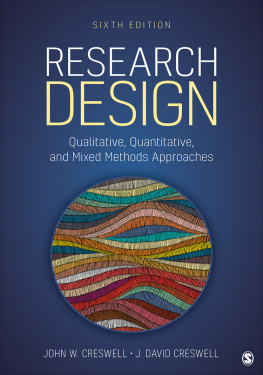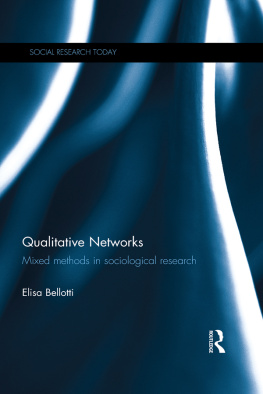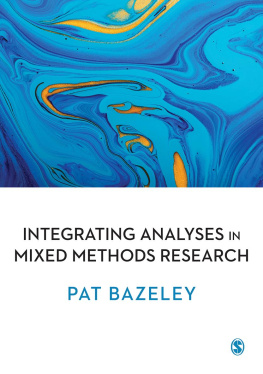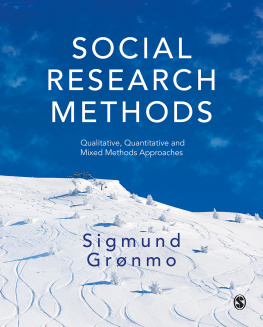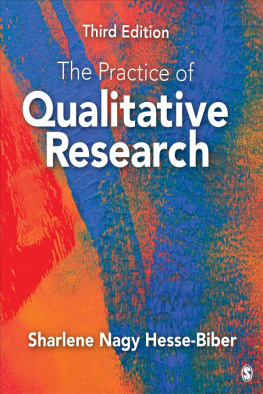SAGE Publications Ltd
1 Olivers Yard
55 City Road
London EC1Y 1SP
SAGE Publications Inc.
2455 Teller Road
Thousand Oaks, California 91320
SAGE Publications India Pvt Ltd
B 1/I 1 Mohan Cooperative Industrial Area
Mathura Road
New Delhi 110 044
SAGE Publications Asia-Pacific Pte Ltd
3 Church Street
#10-04 Samsung Hub
Singapore 049483
Uwe Flick 2018
Apart from any fair dealing for the purposes of research or private study, or criticism or review, as permitted under the Copyright, Designs and Patents Act, 1988, this publication may be reproduced, stored or transmitted in any form, or by any means, only with the prior permission in writing of the publishers, or in the case of reprographic reproduction, in accordance with the terms of licences issued by the Copyright Licensing Agency. Enquiries concerning reproduction outside those terms should be sent to the publishers.
Library of Congress Control Number: 2017943867
British Library Cataloguing in Publication data
A catalogue record for this book is available from the British Library
ISBN 978-1-4739-1211-3 (pbk)
Editor: Mila Steele
Editorial assistant: John Nightingale
Production editor: Victoria Nicholas
Copyeditor: Andy Baxter
Proofreader: Thea Watson
Marketing manager: Emma Turner
Cover design: Shaun Mercier
Typeset by C&M Digitals (P) Ltd, Chennai, India
Printed in the UK
Editorial introduction
Uwe Flick
Introduction to The SAGE Qualitative Research Kit
In recent years, qualitative research has enjoyed a period of unprecedented growth and diversification as it has become an established and respected research approach across a variety of disciplines and contexts. An increasing number of students, teachers and practitioners are facing questions and problems of how to do qualitative research in general and for their specific individual purposes. To answer these questions, and to address such practical problems on a how-to-do level, is the main purpose of The SAGE Qualitative Research Kit.
The books in The SAGE Qualitative Research Kit collectively address the core issues that arise when we actually do qualitative research. Each book focuses on key methods (e.g. interviews or focus groups) or materials (e.g. visual data or discourse) that are used for studying the social world in qualitative terms. Moreover, the books in the Kit have been written with the needs of many different types of reader in mind. As such, the Kit and the individual books will be of use to a wide variety of users:
- Practitioners of qualitative research in the social sciences; medical research; marketing research; evaluation; organizational, business and management studies; cognitive science; etc., who face the problem of planning and conducting a specific study using qualitative methods.
- University teachers and lecturers in these fields using qualitative methods can use this series as a basis of their teaching.
- Undergraduate and graduate students of social sciences, nursing, education, psychology and other fields where qualitative methods are a (main) part of the university training including practical applications (e.g. when writing a thesis).
Each book in The SAGE Qualitative Research Kit has been written by distinguished authors with extensive experience in their field and in practice with the methods they write about. When reading the whole series of books from the beginning to the end, you will repeatedly come across some issues which are central to any sort of qualitative research such as ethics, designing research or assessing quality. However, in each book such issues are addressed from the specific methodological angle of the authors and the approach they describe. Thus you may find different approaches to issues of quality or different suggestions for how to analyze qualitative data in different books, which will combine to present a comprehensive picture of the field as a whole.
What is qualitative research?
It has become more and more difficult to find a common definition of qualitative research which is accepted by the majority of qualitative research approaches and researchers. Qualitative research is no longer just simply not quantitative research, but has developed an identity (or maybe multiple identities) of its own.
Despite the multiplicity of approaches to qualitative research, some common features of qualitative research can be identified. Qualitative research is intended to approach the world out there (not in specialized research settings such as laboratories) and to understand, describe and sometimes explain social phenomena from the inside in a number of different ways:
- By analyzing experiences of individuals or groups. Experiences can be related to biographical life histories or to (everyday or professional) practices; they may be addressed by analyzing everyday knowledge, accounts and stories.
- By analyzing interactions and communications in the making. This can be based on observing or recording practices of interacting and communicating and analyzing this material.
- By analyzing documents (texts, images, film or music) or similar traces of experiences or interactions.
Common to such approaches is that they seek to unpick how people construct the world around them, what they are doing or what is happening to them in terms that are meaningful and that offer rich insight. Interactions and documents are seen as ways of constituting social processes and artefacts collaboratively (or conflictingly). All of these approaches represent ways of meaning, which can be reconstructed and analyzed with different qualitative methods that allow the researcher to develop (more or less generalizable) models, typologies, theories as ways of describing and explaining social (or psychological) issues.
How do we conduct qualitative research?
Can we identify common ways of doing qualitative research if we take into account that there are different theoretical, epistemological and methodological approaches to qualitative research and that the issues that are studied are very diverse as well? We can at least identify some common features of how qualitative research is done.
- Qualitative researchers are interested in accessing experiences, interactions and documents in their natural context and in a way that gives room to the particularities of them and the materials in which they are studied.


